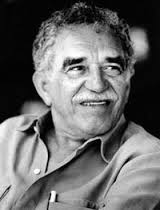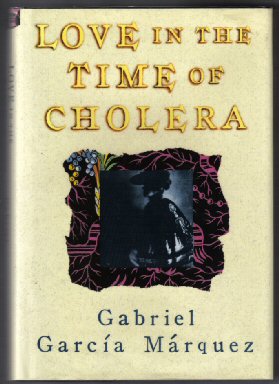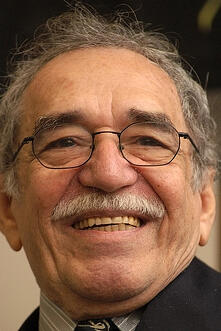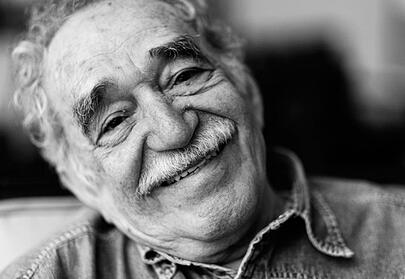The influence of Gabriel Garcia Marquez cannot be overstated. When he passed away in 2014, he was heralded as "the greatest Colombian who ever lived" by Juan Manuel Santos, the president of Colombia at the time. What did Gabriel García Márquez do to be so influential and to be considered so great? He wrote passionately about politics, both at home and abroad, in his non-fiction and journalistic efforts. He pioneered magic realism in his fiction work. As his popularity grew thanks to the success of his novels like One Hundred Years of Solitude which was translated into over 30 languages, García Márquez took advantage of opportunities to mediate peace talks and influence some of the powerful people whose company he kept.
Perhaps the appeal of Gabo is less about what he did on a grand scale, though, and more about how he was relatable to readers of all shapes and sizes, and in a particular way those who shared his Latin American roots. As Isabel Allende stated upon his death, "In his books I found my own family, my country, the people I have known all my life, the colour, the rhythm, and the abundance of my continent."
In Gabo's honor, we've collected several of our past posts to celebrate his birthday. Enjoy!
The Magic of Gabriel García Márquez
Born March 6, 1927, Gabriel García Márquez is one of the 20th century’s leading authors. The earliest living recipient of the Nobel Prize in Literature, García Márquez is best known for his novels, One Hundred Years of Solitude (1967), Autumn of the Patriarch (1975), and Love in the Time of Cholera (1985). Carlos Fuentes called García Márquez, “the most popular and perhaps the best writer in Spanish since Cervantes.”

García Márquez spent the first eight years of his life under the guardianship of his maternal grandparents. It was their stories that fueled his imagination and influenced his work later in life. His grandmother, a talented storyteller, regaled young García Márquez with folktales featuring ghosts and the supernatural. He based his novel, Of Love and Other Demons, on one of her stories.
After the death of his grandfather, García Márquez briefly returned to his parents’ care before entering boarding school. A good student, García Márquez’s family insisted he pursue a law degree. He acquiesced but wrote short stories and articles on the side. After years of study, García Márquez left college to become a full time journalist; he never completed his degree. He began work as a reporter for El Espectadoras where he wrote against government corruption. While there, he penned an expose about the Columbian Navy’s scandalous involvement in a shipwreck. The newspaper, fearing violent repercussions from the story, sent García Márquez to Rome in 1954 as a foreign correspondent.
Since then, García Márquez has lived almost continually abroad in alternating states of voluntary and compulsory exile. After the Columbian government threatened to arrest García Márquez in 1981, Mexico granted him asylum and France awarded him the Legion of Honor. The following year, García Márquez won the Nobel Prize in Literature. Read more >>
Familial and Literary Influences: The Making of Gabriel García Márquez
Nobel laureate Gabriel García Márquez is undoubtedly Colombia’s best known and best loved literary export. His novels, often placed under the umbrella of Magical Realism, bring an unmatched blend of styles and ideas to the rendering of love, death, and loss in his native South America. Though his works—including One Hundred Years of Solitude (1967), Love in the Time of Cholera (1985), and many other internationally acclaimed novels—are unmistakably his own, much of his success has come from the inimitable ways he draws on his literary influences.
 As with so many authors, Márquez's absolute earliest influences were not literary but familial. His grandfather, in addition to being a renowned Liberal war hero from Columbia’s Thousand Days War, was a spirited raconteur. While his grandfather inculcated him into the world of storytelling, his grandmother was his link to what had already been dubbed "Magical Realism" in literary circles. Her fascination with (and complete acceptance of) ghost stories, omens, and premonitions made its way into his consciousness and eventually into his writing, enabling him to enter the literary traditions of writers like Jorge Luis Borges and Julio Cortázar.
As with so many authors, Márquez's absolute earliest influences were not literary but familial. His grandfather, in addition to being a renowned Liberal war hero from Columbia’s Thousand Days War, was a spirited raconteur. While his grandfather inculcated him into the world of storytelling, his grandmother was his link to what had already been dubbed "Magical Realism" in literary circles. Her fascination with (and complete acceptance of) ghost stories, omens, and premonitions made its way into his consciousness and eventually into his writing, enabling him to enter the literary traditions of writers like Jorge Luis Borges and Julio Cortázar.
While the distinction between Magical Realism and Absurdism is a crucial one for thinking about South American literature, it was actually a shot from the latter canon that first turned Márqueztoward the path of fiction writing. He said of Franz Kafka’s The Metamorphosis (1915), many years after first reading it in college:
“When I read the [first] line I thought to myself that I didn’t know anyone was allowed to write things like that. If I had known, I would have started writing a long time ago.”
Blurring Political Lines: Gabriel García Márquez
Gabriel García Márquez won the Nobel Prize for Literature in 1982 "for his novels and short stories, in which the fantastic and the realistic are combined in a richly composed world of imagination, reflecting a continent's life and conflicts.” Affectionately referred to as “Gabo” by nearly everyone in the Spanish speaking community, García Márquez solidified his stature as a national icon with his Nobel Prize. Following his reception of the award, his Colombian countrymen reverently referred to García Márquez as “Nuestro Nobel,” or “our Nobel Prize winner.”
Still, García Márquez was famous in Columbia long before he won a Nobel Prize. He is thought to be one of the country’s true treasures not only for his literary contributions, but perhaps more significantly, for the role he played in Colombian peace negotiations between rival sides in a long standing civil conflict.
The political situation in Columbia is complicated. Its roots can be traced back to La Violencia, which erupted in the late 1940s, right around the beginning of Gabo’s writing career. The violence has continued as conservative and liberal parties as well as guerrillas, drug traffickers, and paramilitary groups all fight for a larger share of power, using any means necessary.
In such a tumultuous political landscape, García Márquez stands out as someone who was respected by all sides. As the editor of Gabo’s news magazine, Cambio, stated in the late 1990s, “People here in Colombia are very interested in whatever Gabo has to say.” Read more >>
The Legacy of Gabriel García Márquez
In November 2014, the University of Texas paid $2.2 million for the archives of Gabriel García Márquez. It is hard to put a price on the private works of a colossal author, but if one is assigned, that price is necessarily significant. So, it seems the scramble for his papers and manuscripts is just one of the ways the world is dealing with García Márquez's illustrious legacy.
 When García Márquez received the Nobel Prize in Literature in 1982, he humbly accepted it as a recognition that transcended his singular body of work. "I have the impression that in giving me the prize," he said of the Nobel committee, "they have taken into account the literature of the sub-continent and have awarded me as a way of awarding all of this literature." While his work was certainly worthy of the honor, García Márquez also made the world brighter for writers in Latin American and beyond.
When García Márquez received the Nobel Prize in Literature in 1982, he humbly accepted it as a recognition that transcended his singular body of work. "I have the impression that in giving me the prize," he said of the Nobel committee, "they have taken into account the literature of the sub-continent and have awarded me as a way of awarding all of this literature." While his work was certainly worthy of the honor, García Márquez also made the world brighter for writers in Latin American and beyond.
García Márquez’s work is not only Latin American in origin; it is inextricably Latin American in mood, setting, and perspective. Whether an American or Western European author could have penned One Hundred Years of Solitude is doubtful. In 1967, the world was introduced to García Márquez’s magnum opus, to the village of Macondo, and to the Buendia family that has lived there for generations. Read more >>
Ten Fascinating Facts About Gabriel García Márquez
Especially on this blog, Love in the Time of Cholera (1985) author Gabriel García Márquezneeds little introduction. William Kennedy declared that Marquez’s One Hundred Years of Solitude (1967) was, "the first piece of literature since the Book of Genesis that should be required reading for the entire human race," and the Nobel Prize committee seemed to more or less agree, bestowing the honor on a Colombian writer for the first time ever largely in recognition of One Hundred Years of Solitude in particular. Carlos Fuentes called him, "the most popular and perhaps the best writer in Spanish since Cervantes." Here are some interesting facts about him.
1. He had one of the more iconic literary feuds of the last century
With Mario Vargas Llosa, a fellow South American Nobel laureate, who once punched Marquez in the eye at a film premiere. Even today little is known about the incident, except that Marquez saw Llosa across the crowd, jovially shouted “Mario!” and in so doing incurred the wrath of the Peruvian novelist. Llosa, visibly angry, mumbled something about his wife Patricia and proceeded to sock one of the greatest living writers in the face.
2. His relationship with his mother was a bit odd
Much has been said of his relationship with grandparents, who would inform the unique blend of realist and magical realist elements that appear in his work and inspired Marquez's creation of Macondo (his go-to fictionalized locale), but less is said about his relationship with his mother. Perhaps that’s because he claims to have not even really met her until he was seven years old, and even afterwards it doesn't appear that she was the world’s most supportive parent. When Marquez won the Nobel Prize, she asserted that she was most proud, as a parent, of “having a daughter who is a nun."
3. He determined he was going to marry his wife when she was just nine years old
For those of you keeping score at home, that’s the same age at which Dante famously fell in love with Beatrice (Marquez himself was around 14 at the time). Unlike Dante’s famous unrequited love, however, Marquez would eventually marry the object of his affection, though (thankfully) not until she was 26.
4. He was inspired to write by an incorrect translation of Kafka’s The Metamorphosis (1915)
Marquez claimed Ernest Hemingway and William Faulkner as major influences during his early years as a writer, but by his account it was his introduction to Kafka’s writing that showed him the vast, anarchic possibilities of literature. Interestingly, however, while Marquez no doubt believed that he was more or less receiving Kafka’s words and ideas, he was actually reading Jorge Luis Borges’ “improved” translation of the text, which, in true Borgesian fashion, contains a number of deliberate changes from the original. Read more >>
Sources: BBC.com here and here










